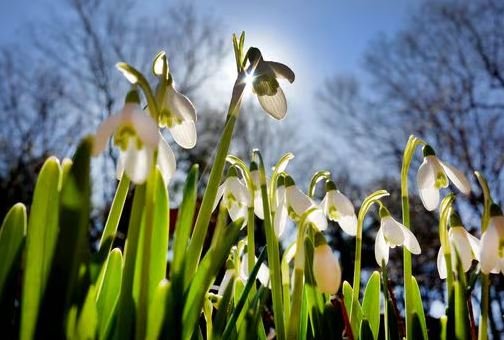Introduction
As the chill of winter fades away, a sense of renewal fills the air.early spring bloomers nyt crossword herald this transition with vibrant colors and delightful fragrances that lift our spirits after months indoors. Imagine stepping into your garden to see the first bursts of life—a symphony of blossoms awakening from their slumber. These flowers not only bring joy but also signal that it’s time to embrace nature’s beauty once again. If you’re looking to add some early spring bloomers nyt crossword to your space, timing is everything! Let’s explore how you can create a stunning garden right when these beauties are ready to shine.
Benefits of planting early blooming flowers
Planting early spring bloomers nyt crossword flowers offers a vibrant start to your garden. They provide color and life when everything else is still waking up from winter.
These blooms can also boost local pollinator populations. Bees and butterflies are often hungry for nectar as they emerge in spring, making your garden a welcoming habitat.
Additionally, early bloomers help combat soil erosion. Their roots stabilize the earth, preventing runoff during rainy spells.
Another benefit is their ability to improve mood. A splash of color and fragrance can transform dull outdoor spaces into cheerful retreats, enhancing mental well-being.
Many early bloomers require less maintenance than summer flowers. This means more time enjoying their beauty rather than working on upkeep.
Timing is key: Factors to consider for the best time to plant early spring bloomers
Timing plays a crucial role in the success of early spring bloomers. It’s essential to consider local climate conditions before planting.
Soil temperature is one factor that shouldn’t be overlooked. Most early bloomers thrive when the soil warms up consistently, typically around 50°F.
Frost dates also matter. Familiarizing yourself with your area’s last frost date can help you avoid potential damage to delicate plants.
Sunlight availability influences growth, too. Early spring days can vary in light hours, affecting how quickly flowers emerge and flourish.
Moisture levels are just as important; consistent moisture ensures seeds germinate effectively without becoming waterlogged or dried out.
Taking these factors into account will set the stage for a vibrant garden filled with beautiful blooms come springtime.
Top 5 early spring bloomers for your garden
When it comes to early spring bloomers, a few stand out for their beauty and resilience.
Crocus is often the first flower to emerge. Their vibrant hues can brighten up any garden after winter’s gloom. Planting them in clusters creates a stunning visual impact.
Next on the list is daffodil. Known for their cheerful yellow faces, these hardy bulbs are not only lovely but also deer-resistant—perfect for those with wildlife visitors.
Another favorite is hyacinth. The fragrant blooms add an aromatic touch to your garden, attracting pollinators as they come alive in spring.
Snowdrops are delicate yet tenacious flowers that thrive even under snow cover. Their understated elegance makes them a charming addition.
Consider primrose. With its variety of colors and long-lasting blooms, it thrives in shady spots where many others fail to flourish.
Tips for successful growth and maintenance of early spring bloomers
To ensure your early spring bloomers thrive, start with soil preparation. Good drainage is essential. Mix in compost to enrich the soil and provide nutrients.
Correct watering practices matter too. Early spring can be unpredictable, so check moisture levels regularly. Water deeply but infrequently to encourage strong root growth.
Mulching helps retain moisture and suppress weeds. A layer of organic mulch not only aids in temperature regulation but also adds nutrients as it breaks down.
Watch for pests and diseases as they can quickly damage young plants. Regularly inspect leaves and stems for any signs of trouble.
Don’t forget about pruning when necessary. Deadheading spent blooms encourages more flowers and keeps your garden looking tidy throughout the season. With these tips, you’ll enjoy a vibrant display from your early spring bloomers all season long!
The role of weather in determining the best time for planting early spring bloomers
Weather plays a crucial role in determining when to plant early spring bloomers. Soil temperature and moisture levels are key factors that affect seed germination and plant growth.
Typically, these flowers thrive when soil temperatures reach around 50°F. This is usually a reliable indicator that it’s time to start planting.
Rainfall patterns also influence timing. Adequate moisture helps seeds sprout, but too much can lead to rot or fungal issues.
Frost dates should be considered as well; unexpected cold snaps can damage tender buds. Monitoring local forecasts keeps gardeners informed about potential weather shifts.
Additionally, regional variations mean different areas may experience warmer springs earlier than others. Observing the unique climate of your location will guide you to find the perfect window for planting those beautiful blooms effectively!
Conclusion
Early spring bloomers are not just a delightful visual treat; they also signal the end of winter and the promise of warmer days ahead. By planting these flowers, you can enjoy an early burst of color in your garden while supporting pollinators that emerge with the first hints of spring.
Timing is essential when it comes to planting these blooms. Factors such as soil temperature, frost dates, and local climate conditions play a crucial role in determining when to plant your flowers for optimal growth.
Selecting the right plants for your garden makes all the difference. The top five early spring bloomers—like crocuses, daffodils, hyacinths, primroses, and tulips—not only add beauty but also thrive during this season.
Don’t forget about proper care after planting. Regular watering and appropriate fertilization will ensure successful growth throughout their flowering period.
Weather patterns significantly influence how we approach gardening each season. Monitoring temperatures and precipitation can help you decide on the best time to plant your early spring bloomers.
The journey into vibrant blooms begins with understanding timing and care specifics tailored to your region’s unique environment.


